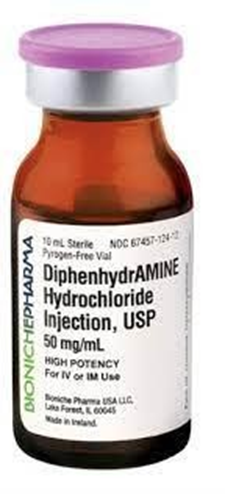A nurse is preparing to administer diphenhydramine 30 mg IM stat to a client who is having an allergic reaction. Available is diphenhydramine 50 mg/mL. How many mL should the nurse administer per dose? (Round the answer to the nearest tenth. Use a leading zero if it applies. Do not use a trailing zero.)
The Correct Answer is ["0.6"]
To calculate the dosage of diphenhydramine, the nurse needs to use the formula D/H x Q
= X, where D is the desired dose, H is the on-hand dose, Q is the quantity of the on-hand dose, and X is the amount to administer. In this case, D is 30 mg, H is 50 mg/mL, and Q is 1 mL. Plugging these values into the formula, we get:
30/50 x 1 = 0.6

Nursing Test Bank
Naxlex Comprehensive Predictor Exams
Related Questions
Correct Answer is ["A","B","C","E"]
Explanation
A. This an example of a health care-associated infections (HAIs), which are infections that patients acquire during the course of receiving health care treatment for other conditions. The patient acquired the pneumonia after being in a ventilator.
B. This is an example of a HAI since the patient acquired the condition while receiving health care treatment for other conditions.
C. This is an example of a HAI since the patient acquired the condition while receiving health care treatment for other conditions.
D. This is not an example of a health care-associated infection (HAI), because it is not acquired during the course of receiving health care treatment. This is an example of a community-acquired infection, which is an infection that a person gets from contact with people or sources outside of a health care setting.
E. This is an example of a HAI since the patient acquired the condition while receiving health care treatment for other conditions.
Correct Answer is D
Explanation
A. The use of an incentive spirometer is more relevant for preventing respiratory complications, not related to the client's low WBC count.
B. Negative-pressure airflow rooms are typically used for clients with airborne infections, not those with low WBC counts.
C. Cooked fruits may be advisable to reduce the risk of bacterial contamination in immunosuppressed clients, but it does not directly address the low WBC count.
D. Reporting temperatures greater than 39.5°C (102.3°F) lasting more than 4 hours is crucial as it may indicate an infection, and prompt intervention is needed in immunosuppressed clients.
Whether you are a student looking to ace your exams or a practicing nurse seeking to enhance your expertise , our nursing education contents will empower you with the confidence and competence to make a difference in the lives of patients and become a respected leader in the healthcare field.
Visit Naxlex, invest in your future and unlock endless possibilities with our unparalleled nursing education contents today
Report Wrong Answer on the Current Question
Do you disagree with the answer? If yes, what is your expected answer? Explain.
Kindly be descriptive with the issue you are facing.
